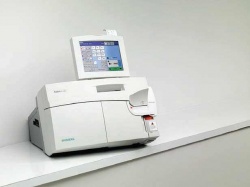Remote blood gas data management
Point of care testing (POCT) at a busy UK hospital
The 500-bed Warrington Hospital in the north-west of England has introduced rapid, accurate POCT to its wards. The hospital was one of the first in the UK to install Siemens RAPIDLab 1200 Blood Gas Analyzers and the RAPIDComm v3.0 Data Management System. More recently, it has installed Clinitek Status Connect systems to further enhance its operations.


A key factor in the decision to upgrade its Blood Gas analysers was because existing equipment was experiencing problems and letting down staff.
The point of care (POC) team at the hospital - with a full-time POC coordinator and two part-time biomedical scientists - is responsible for ensuring the smooth running of RAPIDLab Blood Gas analysers at seven locations throughout the hospital, all connected to RAPIDComm to enable remote management.
From the laboratory, the POC team can monitor analyser status and manage user operations, enabling it to pre-empt problems before they impact on clinical users.
Previously, if there were problems, the POC representative would have to talk issues through with clinical staff by phone. Now, using RAPIDComm, analysers on the ward can be viewed and issues resolved remotely. This positively affects the team’s workflow management, especially out-of-hours.
Focusing on emergency and specialist care, the Warrington conducts more than 50,000 POC tests a year. Monthly test totals include 500 from the A&E department, 100 from the operating theatre, 1,100 from the haematology and transplant unit, 1,200 from the intensive therapy unit, 400 from the neonatal ward and 250 from the maternity unit.
The RAPIDLab 1200 Blood Gas Analyser delivers results for all parameters within 60 seconds with a comprehensive test menu (pH, pCO2, pO2, Na+, K+, Ca++, Cl-; Glucose, Lactate, Neonatal Bilirubin; and full COoximetry).
The RAPIDComm v3.0 Blood Gas and Urinalysis Data Management and Connectivity Solution allows centralised management of multiple Siemens analysers and operators, while the Clinitek Status Connect System brings connectivity and testing oversight to POC urinalysis.
The analysers are compact in design for placement on wards or specialist units. Results from samples are delivered promptly on-screen and are recorded on-board.
POC co-ordinator Celia Critchley said: ‘The first major benefit of IT powered integration is less manual maintenance and less walking around the hospital. For example, with the RAPIDLab analysers in locations such as A&E and ITU linked by RAPIDComm, we can see how they are operating at any time, simply by logging onto the user interface screen on the workstation inside the Lab.’ This has saved time on maintenance, she added, because the software monitors that all is well and undertakes problem solving processes if needed.
The benefits of modernised POC systems and processes include: remote monitoring and management of analysers; increased compliance control; password protection (only trained/authorised staff can access RAPIDLab analysers); reduced use of consumables e.g.
15.02.2012











